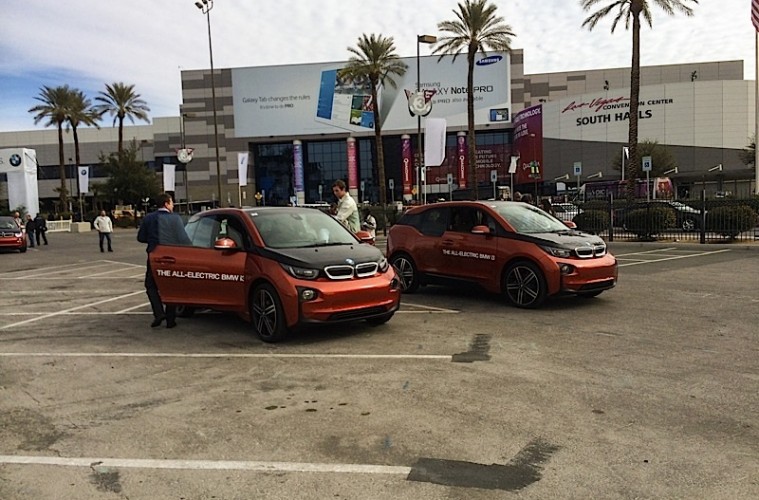The BMW i3 is the Bavarian’s first attempt to make an all-electric small family car. Designed to be a family hatchback and a city runabout, the i3 has the potential to be BMW’s most successful EV attempt, and lure luxury buyers who now can only choose from the Tesla Model S (on the high-end), or vehicles like the Ford Focus Electric or Fiat 500 E (on the low end). We take a drive down the Las Vegas strip to check out the car, its dynamics, and overall impressions. We leave the drive impressed, but believe there are a few issues that need worked out before they are officially on-sale.
READ: Tesla Model S Test Drive Through Google Glass
Starting the i3 is like starting any other modern BMW; press the brake and push the starter button. But unlike many modern BMWs, the start button and gearshift selector is located on the steering column and not in the center console. The relatively small Bimmer benefits from this decision, making the center console more open and giving the front two passengers more room.
The gearshift selector is a thumb-toggle style device, with a “P” button on the top to put the vehicle in park. Admittedly, it is a bit awkward to use the first time, but might become natural after spending a little time with the vehicle.
As for other creature comforts, the i3 has BMW’s i-Drive interface with navigation, single zone automatic temperature control, and a glass roof (that does not open). In an effort to save weight, BMW has ditched the fully-powered seats for a manual set. They are comfortable, but we believe many BMW drivers would prefer an automatic set with memory.
Driving the i3 is not really like driving any other car. Yes, there is a steering wheel, an accelerator pedal, and a brake pedal. But the automatic transmission does not have a “creep” function when the driver lets off the gas. The vehicle will sit stationary with no feet on either pedal (like a manual transmission-equipped vehicle in neutral). This really does take some getting used to, because it is unnatural for many people and might even be troublesome for people instinctively knowing which pedal to press when they are stopped a traffic light.
Acceleration is brisk. Based on our “butt dyno” the BMW i3 does feel quicker and torquier than the Ford Focus Electric we drove last year. There are three different settings that control the drivetrain, but unlike some of their sportier offerings, this vehicle has Comfort, Economy, and Economy+. The full economy setting will turn off the air conditioning unit, and limit speed to provide the longest range per charge.
Regardless of setting, the regenerative braking is fairly aggressive. As soon as you lift of the accelerator, the vehicle starts slowing as if the brakes were pressed lightly. Again, it does take some getting used to, even over some of the hybrid-electric vehicles that we have driven in the past.
Cabin noise is there, but not from the electric-motor as much as tire noise and traffic outside. Sound dampening is generally heavy, so EVs try to get by with the bare minimum to save energy. The car is by no means noisy, but might not be as quiet as some luxury vehicle buyers are used to.
After the drive, BMW took the opportunity to survey us about what we liked and do not like about the drive. This tells us that BMW is looking to tweak the vehicle still before offering it for mass consumption. We liked that the car felt sporty, even for a family car. It does drive like a BMW. However, there are a few little things that we hope are changed, such as the creep function, before it goes on sale (or available as an update after launch).
Despite the little niggles, we believe the BMW i3 will sell well, and look forward to providing a full review in the future.






